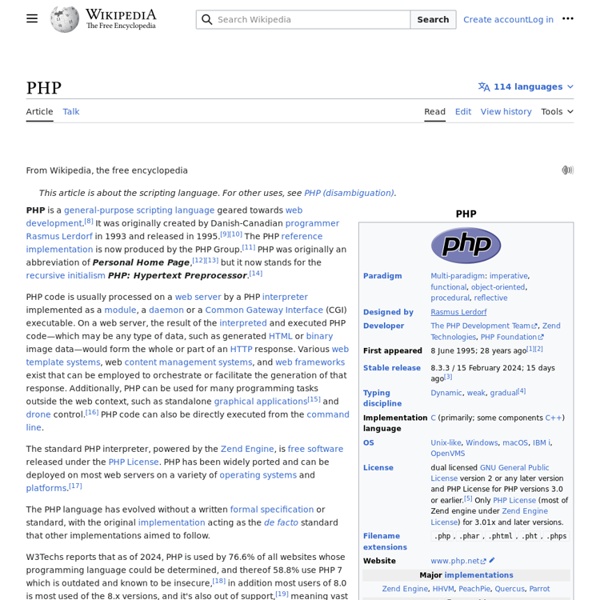Hypertext Transfer Protocol
The Hypertext Transfer Protocol (HTTP) is an application protocol for distributed, collaborative, hypermedia information systems.[1] HTTP is the foundation of data communication for the World Wide Web. The standards development of HTTP was coordinated by the Internet Engineering Task Force (IETF) and the World Wide Web Consortium (W3C), culminating in the publication of a series of Requests for Comments (RFCs), most notably RFC 2616 (June 1999), which defined HTTP/1.1, the version of HTTP most commonly used today. In June 2014, RFC 2616 was retired and HTTP/1.1 was redefined by RFCs 7230, 7231, 7232, 7233, 7234, and 7235.[2] HTTP/2 is currently in draft form. Technical overview[edit] URL beginning with the HTTP scheme and the WWW domain name label. A web browser is an example of a user agent (UA). HTTP is designed to permit intermediate network elements to improve or enable communications between clients and servers. History[edit] The first documented version of HTTP was HTTP V0.9 (1991).
PHP: Hypertext Preprocessor
Internet Protocol
This article is about the IP network protocol only. For Internet architecture or other protocols, see Internet protocol suite. The Internet Protocol (IP) is the principal communications protocol in the Internet protocol suite for relaying datagrams across network boundaries. Historically, IP was the connectionless datagram service in the original Transmission Control Program introduced by Vint Cerf and Bob Kahn in 1974; the other being the connection-oriented Transmission Control Protocol (TCP). The first major version of IP, Internet Protocol Version 4 (IPv4), is the dominant protocol of the Internet. Function[edit] The Internet Protocol is responsible for addressing hosts and for routing datagrams (packets) from a source host to a destination host across one or more IP networks. Datagram construction[edit] Sample encapsulation of application data from UDP to a Link protocol frame IP addressing and routing[edit] IP routing is also common in local networks. Reliability[edit] Security[edit]
Less PHP Database Code Using The Factory Design Pattern | Gerd Riesselmann: Notes From the Bog
It's PHP design pattern time again! Today I'll show a simple way to Encapsulate database access in a classMake queries return objects rather than records or arraysReduce code to process database results All this is achieved by using the factory pattern. Read on! It usually is a good idea to encapsulate database access into a class. If you start to wrap db code fragments into a class, however, you'll notice that having hidden MySQL inside a neat little class, you still have code like while ($record = mysql_fetch_array($dbHandle)) doSomething($record); spread all over your application. Well, not necessarily. The idea of the factory pattern is to use a function to create an instance of a class rather than calling the constructor using new. Let's start with a simple class like this one: class Person { var $firstName = ""; var $lastName = ""; var $age = 0; function Person($firstName, $lastName, $age) { $this->firstName = $firstName; $this->lastName = $lastName; $this->age = $age; } }
File Transfer Protocol
FTP is built on a client-server architecture and uses separate control and data connections between the client and the server.[1] FTP users may authenticate themselves using a clear-text sign-in protocol, normally in the form of a username and password, but can connect anonymously if the server is configured to allow it. For secure transmission that hides (encrypts) the username and password, and encrypts the content, FTP is often secured with SSL/TLS ("FTPS"). SSH File Transfer Protocol ("SFTP") is sometimes also used instead, but is technologically different. History[edit] The original specification for the File Transfer Protocol was written by Abhay Bhushan and published as RFC 114 on 16 April 1971. Protocol overview[edit] Communication and data transfer[edit] Illustration of starting a passive connection using port 21 The server responds over the control connection with three-digit status codes in ASCII with an optional text message. ASCII mode: used for text. Login[edit] Syntax[edit] or:
php - Zend framework installation errror
Server-side Programming
Most of the websites are created from static documents and image files. If you want to create an advanced website with forms handling, dynamically generated pages, shopping carts, content management systems, databases, and so on, you should learn a server-side programming language. The main difference between client-side and server-side programming is that client-side scripts are downloaded, interpreted and executed by the browser and the server-side scripts run on a server. The scripting and programming languages that are used to create server-side applications are: ASP, ASP.NET, PHP, JSP, ColdFusion, Ruby on Rails and more. Asp (Active Server Pages) is a server-side scripting language created by Microsoft. Microsoft marketed ASP as an add on for IIS. ASP.NET is part of Microsoft .NET platform. PHP is a widely-used general-purpose scripting language that is especially suited for Web development and can be embedded into HTML.
WebDevbyJoss: Easy start with Jenkins for PHP developer
Lets look into the quick and minimal Jenkins setup for middle sized fast growing PHP project. In order to easy follow this article you should at least:have PEAR installed on serveruse phpUnit for unit testsbuild your app with Phing On my Ubuntu 12.04 LTS its only four CLI commands: # wget -q -O - | sudo apt-key add - # sudo sh -c 'echo deb binary/ > /etc/apt/sources.list.d/jenkins.list' # sudo apt-get update # sudo apt-get install jenkins Jenkins will be available under by default. Go to "Manage Jenkins" > "Manage Plugins" in order to install plugins required for PHP project: Phing - run Phing targetsxUnit - parse phpUnit log files Now when all plugins are installed we can configure our project. Click "New Job", input job name, select "Build a free-style software project" and click "OK" New Job is created and you will be redirected to Job configuration page. Click "Save" and start build.



